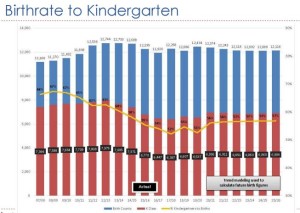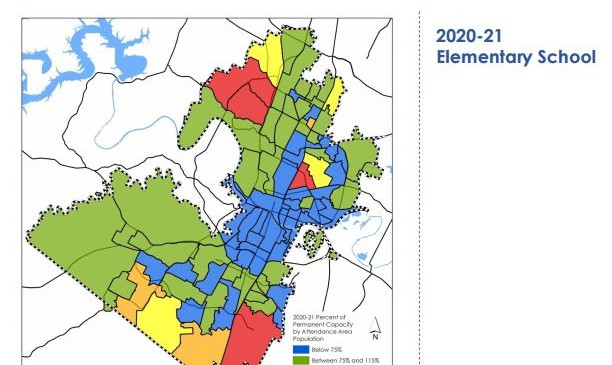Shrinking AISD enrollment could be new normal
Wednesday, January 13, 2016 by
Courtney Griffin Trustees for the Austin Independent School District are asking district staff to let them know what variables they have control over after hearing grim student enrollment projections.
At Monday’s workshop meeting, board members heard the results of an annual demographics report conducted by Davis Demographics & Planning Inc. The yearly report estimated that AISD’s enrollment will drop to 77,628 students by 2025, a reduction of 6,140 from AISD’s total 2015 enrollment. The decline is greater than was previously predicted.
Beth Wilson, AISD assistant director of planning and services, said the 10-year forecast estimates that the district’s student population will decrease by less than 1 percent annually. The loss, she said, is starting at the bottom, with smaller kindergarten classes; as students in those classes age, the effects will spread to the higher grades.
The “vast majority” of the predicted decline comes from Austin’s increasing housing and rental costs, Wilson said, but lower birth rates and competition from private and charter schools are also contributing factors. The dips in enrollment, however, will not occur uniformly across the district.
“There are areas of the district that will continue to grow, including most notably Northwest Austin, more South Central Austin and southeast regions of the district,” Wilson said, adding that the central and eastern portions of the city will experience declines.
Unevenly distributed student population is a problem AISD has already experienced to some degree, with under-enrollment leaving empty seats in some facilities as overcrowding leaves less elbow room in others.
“This is not new – we’ve had this conversation before,” said AISD Superintendent Paul Cruz, pointing to the measures AISD has already taken to try to address uneven enrollment distribution and overall declines.
In this calendar year alone, AISD paid $350,000 to a marketing firm to let families new to the area know about the district’s specialty academic programming. In addition, the district added and expanded pre-kindergarten for 3-year-olds, redrew attendance zones, redrafted transfer policies to allow for out-of-district students and refurbished many of its former academic programs, such as expanding the early college programming to the under-enrolled Travis High School.
AISD trustees have also created a new advisory committee to address facility and planning difficulties, purchased land in South Austin in an attempt to get ahead of overcrowding and continued talks about further expansions in academic programming.
But despite proactive measures, city of Austin demographer Ryan Robinson said AISD’s declining and unevenly distributed student population will be the new normal for several years given Austin’s skyrocketing housing prices. “Look at the collection of cities we are all of the sudden with: New York City, San Francisco, San Jose, parts of L.A.,” Robinson said. “We’re headed in that direction. … The fact that we are all of the sudden in that comparable set is very, very sobering.”
According to the report, 61 percent of Austin’s two-bedroom housing options fall outside the price range for families with a combined income of about $77,000. Ninety percent of two-bedroom housing options are unaffordable for families with a combined income of about $58,000.
In addition, of the 11,337 units being built in Austin currently, only 3,840 of those units are classified as single-family homes. “That’s one of our great fears, with all the construction happening in the central city, very little of it is going to be even two bedrooms, much less … family-style,” Robinson said.
While families may move into other types of housing units, that scenario is less likely and has not happened to a great degree in the past, Robinson added. The best thing AISD can do is hope to team up with the city to push for more diverse housing options and continue its efforts in specialty academic programs, he said.
District 3 Trustee Ann Teich mentioned the elephant in the room: potentially shuttering older schools that continue to remain under-enrolled despite programming efforts.
“It takes our district, as agile as we’d like to be, a long time to react,” Interim President Amber Elenz said. “We can’t turn on a dime, if you will. The more predictive we can get on these things, it will allow us to get more ahead.”
AISD has lost about 3,000 students to date since 2012, according to the district. At the meeting, Chief Financial Officer Nicole Conley estimated that loss to have cost a total of $49 million in funding. AISD receives an estimated $45 a day for every student who attends school in the district.

Update: Here is KUT’s coverage of all this, courtesy of reporter Kate McGee, made available through our reporting partnership.
Map and chart courtesy of AISD, presentation embedded below.
Download (PDF, 4.04MB)
You're a community leader
And we’re honored you look to us for serious, in-depth news. You know a strong community needs local and dedicated watchdog reporting. We’re here for you and that won’t change. Now will you take the powerful next step and support our nonprofit news organization?











